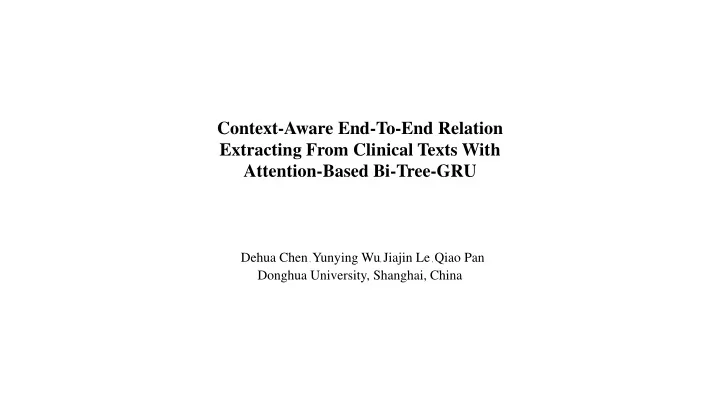

Context-Aware End-To-End Relation Extracting From Clinical Texts With Attention-Based Bi-Tree-GRU Dehua Chen , Yunying Wu , Jiajin Le , Qiao Pan Donghua University, Shanghai, China
Tagging Scheme: 多个 混合性 回声 (B) Beginning B-ATT I-ATT B-IND (I) Insider (O) Outsider The beginning The insider The beginning of Attribute of Attribute of another entity Entity: (LOC)Anatomical Location: right lobe /left lobe/narrow isthmus… echos / nodule/size… (IND)Index : mixed/ multiple… (ATT)Attribute : Relation: (Loc-Ind)Location-Index (Ind-Att) Index-Attribute (Ind-Sub Ind) Index-Sub Index (U)Unknown
Correct type of entity Correct boundary of entity Complicated in Chinese Clinical Texts Correct relation
Input Representation Preparation 1: A sentence Dependency Parsing Tree echo Preparation 2: Three elements of words mixed (word/Part Of Speech/Dependency Relation) multiple Dependency Relation resulted from Dependency Parsing Tree Embeddings
Clinical Entity Extraction
Clinical Relation Extraction Sub-Sentence Level Attention Entity Level Attention
Entity Level Attention 1.The representation vectors of the children nodes 2.A weighted sum of its children embeddings Attention Layer 3.GRU (Gated Recurrent Unit) 4.bidirectional output vector
Sub-Sentence Level Attention k context sub-sentences To capture the relationship between the target sub-sentence and it context sub-sentences Target Sentence Context Sentences
Dataset ultrasonic reports, X-ray/CT reports, Puncture reports, pathology reports of thyroid and mammary gland fromRuijin Hospital. True Positive (TP) the number of entity types are identified as correct and boundaries are matched in NER or the numbers of correct relation types in RE. False Positive (FP) the number of incorrectly identified entities or relations that do not meet the above conditions. False Negative (FN) the number of unidentified entities or relations.
Comparison of different entity-level attention Comparison of different sub sentence-level attention on the whole thyroid dataset on the whole thyroid dataset Shortest Path Tree(SP-Tree) [1] only consists of the nodes “Simple Attention” [2] simply uses a weighted sum on the shortest path in dependency parsing tree between the of all the sub-sentences including a waited target entity pairs classification of relation in one sentences and not SubTree selects the nodes in the subtree under the lowest distinguish the target pairs from other context sub- common ancestor of the target entity pair sentences FullTree take all the nodes into the entity-level attention. 1.Miwa M., Bansal M.: End-to-End Relation Extraction using LSTMs on Sequences and Tree Structures[C]. Meeting of the Association for Computational Linguistics. 1105-1116 (2016). 2.Zhou P., Shi W., Tian J., Qi Z., Li B., Hao H., et al: Attention-Based Bidirectional Long Short-Term Memory Networks for Relation Classification[C]. Meeting of the Association for Computational Linguistics. 207-212 (2016).
Recommend
More recommend